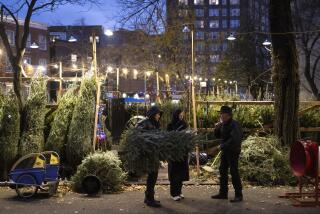Artificial Trees Uprooting Traditional Market : Marketing: Technical innovations and improved manufacturing processes have enabled the fake variety to nearly overtake nature’s product in sales.
- Share via
WASHINGTON — Tacky, perhaps, but true: Artificial Christmas trees are challenging the real variety for hegemony in the nation’s living rooms this holiday season.
Thanks to changing demographics and improved manufacturing processes, fake trees--in green and pink silk, shiny, fold-up aluminum and pre-flocked plastic--have gradually been supplanting nature’s own for the past two decades. The marketing battle has become so intense that the National Christmas Tree Assn. will spend almost $1 million on an advertising and public relations blitz this month to push the real thing.
“A real tree means tradition,” declared David Baumann, an executive with the 2,800-member growers’ organization, echoing the ad message. “When people remember their holiday experiences, they remember the feel, look and smell of a tree that came out the ground.”
On the other hand, the NCTA estimates that the manufactured varieties will show up in one-third of all American households this year, contrasted with a 38% market share for real trees (the balance of households don’t have a tree of any type due to religious, economic or other reasons). Twenty years ago, artificial trees held only about 15% of the market.
Marketers of fakes--which are often sold under natural-sounding brand names--say they are more convenient, durable and safer than real pines or firs. “They’re flame resistant,” pointed out Joseph Carroll, a spokesman for Woolworth Corp., whose 1,100 F. W. Woolworth stores stock only artificial trees. ‘And you don’t have to worry about the needles falling off.’
Such retailers as Woolworth and K mart, which also carries only fakes throughout its 2,200 stores, like artificial trees because they have a longer shelf life than the real ones, which means they can be sold in July as well as in December. And at prices ranging up to $149.99, the manufactured variety provide bigger profits per unit for the stores that carry them. Full-sized natural trees start at around $35 in the Washington area, and in some areas sell for twice that.
Fake trees were first mass-marketed in the United States in the 1950s but were slow to catch because they looked, well, fake. However, advances in technology by manufacturers in Japan, Korea and Taiwan (the U.S. runs an artificial-tree trade deficit) have helped close the gap. “I have to give them credit,” said Bob Blair, a part-time Christmas tree grower and wholesaler who lives in McLean, Va. “The silk-flower manufacturers have gotten pretty good.”
In addition, such real-tree proponents as Baumann also say the aging of the baby boom generation has both helped and hurt the real-tree market. As younger people form households and have children of their own, they tend to go for real trees, but their “empty-nester” parents seek the convenience of the artificial kind, he said. This has kept sales of natural Christmas trees growing, to an estimated 35.2 million this year, but has also helped build a market for artificial products.
To protect the $700-million-a-year retail trade, Christmas-tree growers and street-corner retailers have been marketing new services and products. For example, Bob Blair, responding to complaints about falling needles, now sells a plastic bag with his trees that can be pulled up and around the tree for easier disposal. And in an effort to woo older customers, an increasing number of merchants offer to set up and dispose of trees they sell.
Apart from the artificial-tree sellers, real-tree sellers in urban areas face other unnatural enemies--dwindling open space for lots, high liability insurance rates (starting at $300 for $1 million of coverage) and losses from pilferage and theft. Generally speaking, the average operator gets about a 20% return on his or her investment for one long month of dawn-to-dark workdays.
“Most people don’t get rich doing this,” said Baumann, “but there’s a lot to be said about . . . selling a product that makes people happy.’
More to Read
Inside the business of entertainment
The Wide Shot brings you news, analysis and insights on everything from streaming wars to production — and what it all means for the future.
You may occasionally receive promotional content from the Los Angeles Times.










